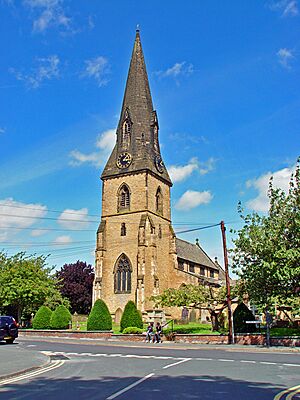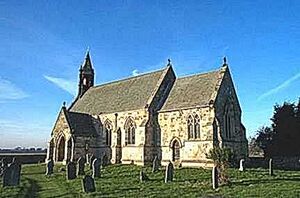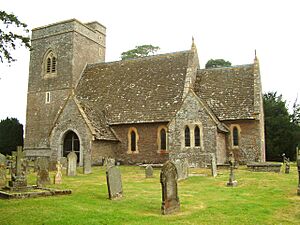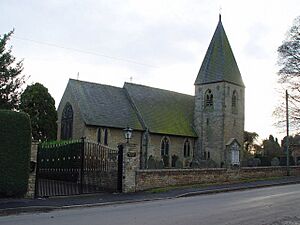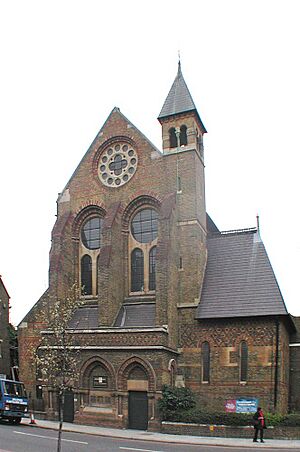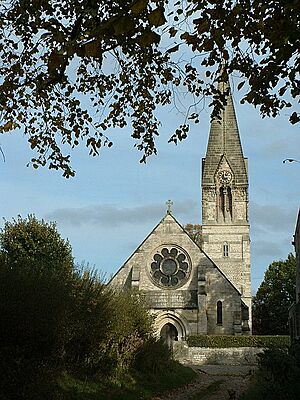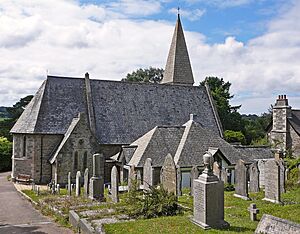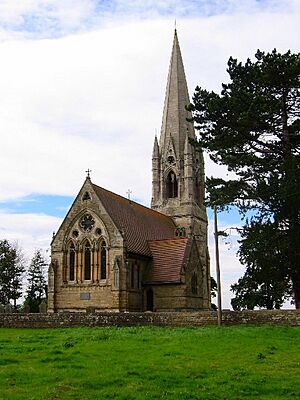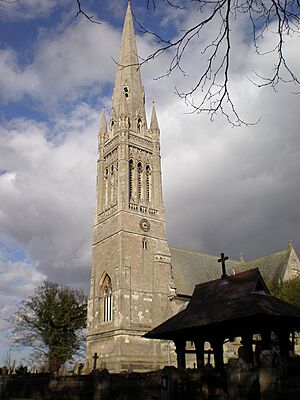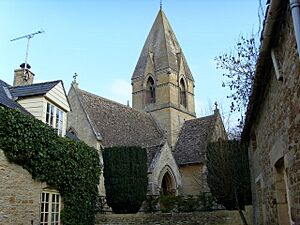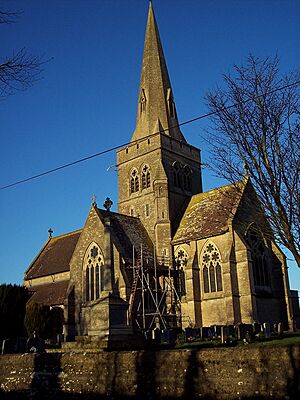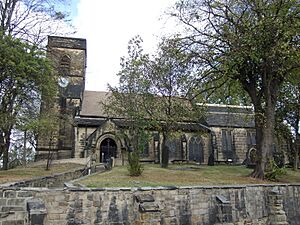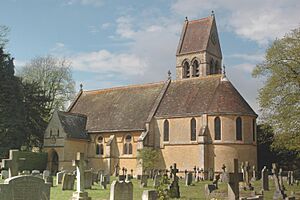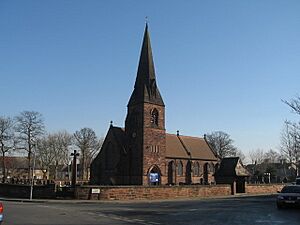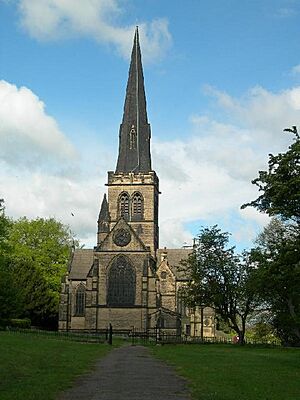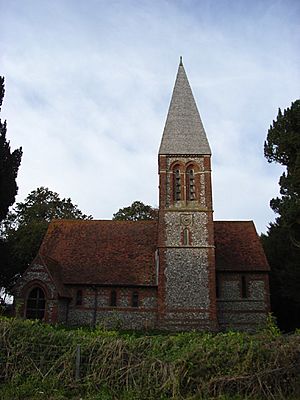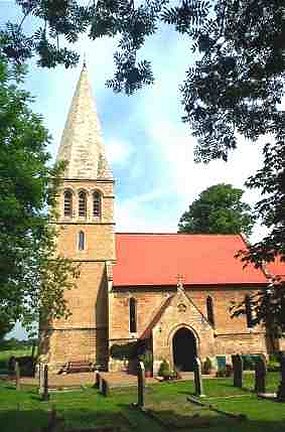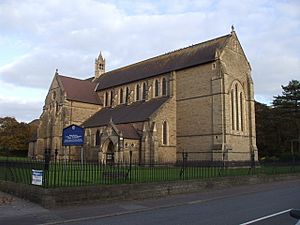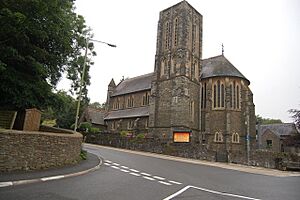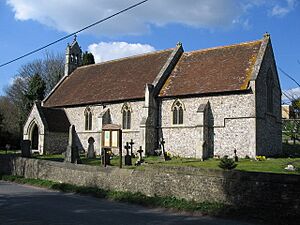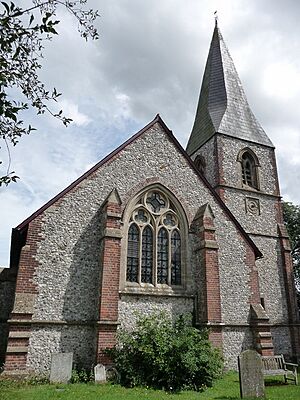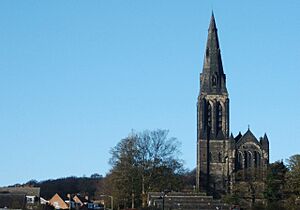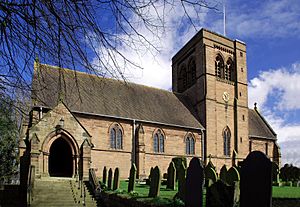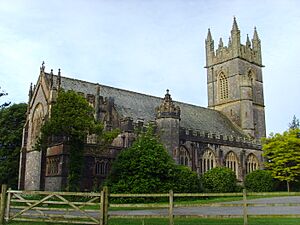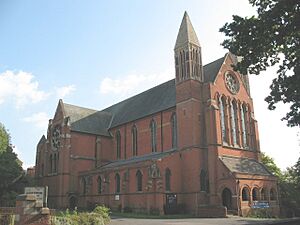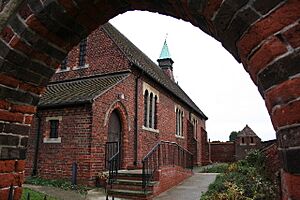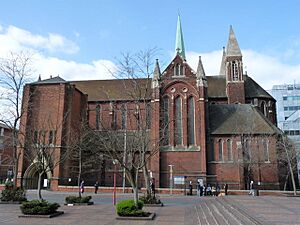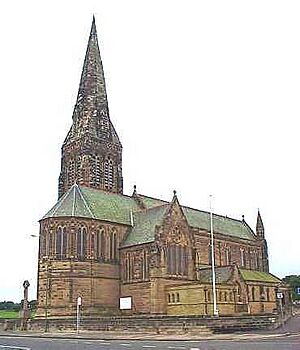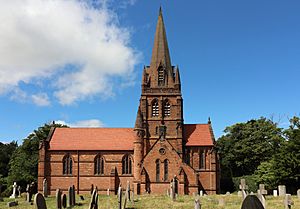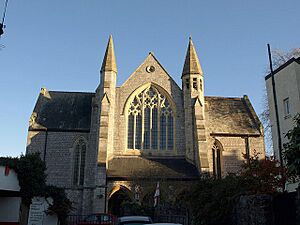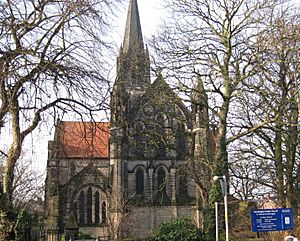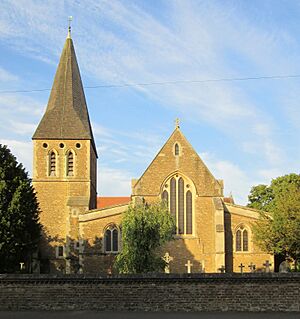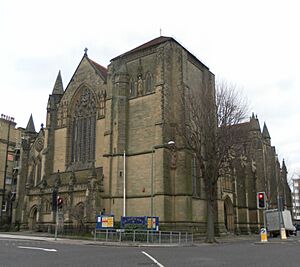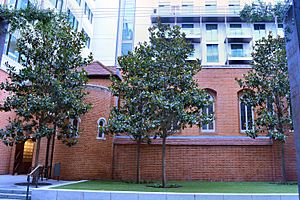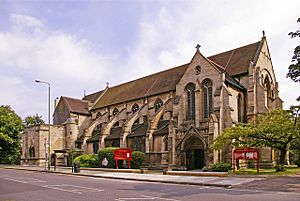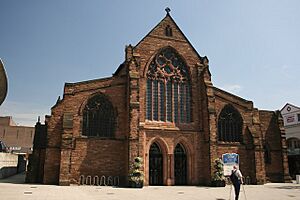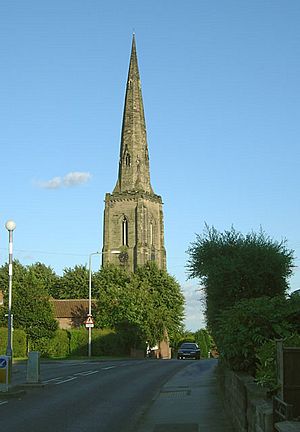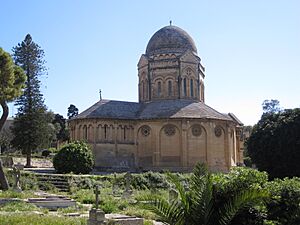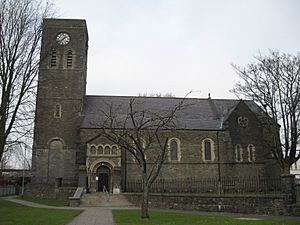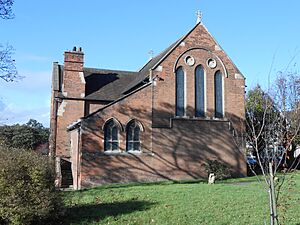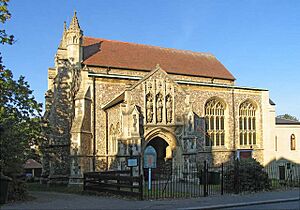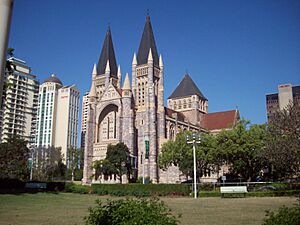List of new ecclesiastical buildings by J. L. Pearson facts for kids
John Loughborough Pearson (1817–1897) was a famous English architect. He mostly designed churches. Pearson was born in Brussels, which was then part of the United Kingdom of the Netherlands. He grew up in Durham, England.
Pearson started learning about architecture with Ignatius Bonomi in Durham. He became Bonomi's main helper. In 1841, he moved to London and lived there for the rest of his life. He worked for other architects like Anthony Salvin and Philip Hardwick. His first church design was a small one in Ellerker, East Riding of Yorkshire. This helped him start his own architecture business.
Contents
What Kind of Buildings Did He Design?
Pearson designed many new churches, from small country churches to big city ones. One of his most famous works is St Augustine's Church in Kilburn, London. It's often called his "masterpiece."
Towards the end of his life, he designed two new cathedrals: Truro Cathedral in Cornwall, England, and Brisbane Cathedral in Australia. The Brisbane Cathedral was built after he died, and his son, Frank, oversaw the work.
Pearson also worked on existing churches. He added new parts, changed old ones, or helped restore them. He worked on many cathedrals, including Lincoln, Peterborough, Bristol, Rochester, Leicester, and Gloucester.
He didn't just design churches! Pearson also created other types of buildings. These included schools, houses for vicars (church leaders), small homes, and even large country houses like Quarwood in Gloucestershire. He designed Two Temple Place in London as an office for a wealthy person named William Waldorf Astor. Pearson also designed buildings for Sidney Sussex College and Emmanuel College at Cambridge University.
Where Did He Work?
Most of Pearson's buildings are in England. He worked on at least 210 church buildings there! But he also worked in other places. For example, he designed Treberfydd, a country house in Wales, and Holy Trinity Church in Ayr, Scotland.
Further away, besides Brisbane Cathedral in Australia, he designed a chapel for a cemetery in Malta.
His Design Style
Pearson almost always used the Gothic Revival style. This style brings back the look of medieval Gothic churches with their pointed arches and tall spires. However, he sometimes used other styles. For example, he used Tudor Revival at Two Temple Place and Jacobean at Lechlade Manor in Gloucestershire. For the cemetery chapel in Malta, he mixed Romanesque Revival and Gothic Revival styles.
His Legacy
Pearson received the Royal Gold Medal from the Royal Institute of British Architects in 1880. This is a very important award for architects.
His son, Frank Loughborough Pearson, worked with him and finished some of his projects after his death. Frank then continued his own architecture career. John Loughborough Pearson died at his home in London and was buried in Westminster Abbey, a very famous church. He left behind a large sum of money, showing how successful he was.
This list shows some of Pearson's most important new church designs. Many of them are listed as important historical buildings in England.
Understanding Building Grades
Buildings in England are given special "grades" to show how important they are historically or architecturally.
- Grade I: These are buildings of amazing interest, sometimes known around the world.
- Grade II*: These are very important buildings, more special than just "special interest."
- Grade II: These are buildings important to the country and have special interest.
In Scotland, buildings are given "categories":
- Category A: These are buildings of national or international importance, either for their architecture or history, or they are great examples of a certain time, style, or building type.
Some of His Important Buildings
| Name | Location | Photograph | Date | Notes | Grade |
|---|---|---|---|---|---|
| St Anne | Ellerker, East Riding of Yorkshire |
1843–44 | A simple church with a nave (main part), chancel (area around the altar), and a west bellcote (small bell tower). | II | |
| Wauldby Chapel | Welton, East Riding of Yorkshire |
1844 | A chapel behind Wauldby Manor Farm in Gothic Revival style. | II | |
| All Saints | North Ferriby, East Riding of Yorkshire |
1845–48 | A limestone church with a west tower topped by a broach spire (a spire rising from a square tower without a break). | II | |
| St Mary | Ellerton, East Riding of Yorkshire |
1846–48 | A stone church with a nave, south porch, chancel with a north vestry (room for clergy), and a west bellcote. | II | |
| St James | Weybridge, Surrey | 1848 | An additional south aisle (side part of a church) was added in 1864. | II* | |
| St Matthew | Landscove, Devon | 1849–50 | A stone church in Decorated style. It has a tower at the east end of the south aisle with a broach spire. | II* | |
| St Gastyn | Llangasty Tal-y-llyn, Llangors, Powys, Wales | 1850 | Rebuilt an older church on the same spot. It's in Early English style with a west tower. | II* | |
| St Mary | Broomfleet, East Riding of Yorkshire |
1857–61 | A limestone church with a north tower. | II | |
| St Peter's, Vauxhall | Lambeth, Greater London | 1863–64 | Built with different colored bricks and stone, it has an apsidal chancel (a rounded end to the chancel). | II* | |
| Christ Church | Appleton-le-Moors, North Yorkshire |
1863–65 | A limestone church with a southeast tower topped by a pyramid-shaped spire. | I | |
| St Joan and St Petroc | Devoran, Cornwall | 1865 | Built with slatestone and granite, the church has a very steep southwest steeple. | II | |
| St Bartholomew | Eastoft, North Lincolnshire | 1855 | A sandstone church with a nave, aisles, a south porch, a chancel with a north vestry, and a tall triple bellcote. | II | |
| St Mary | Catherston Leweston, Dorset | 1857–58 | A small church made of chert (a type of stone) and stone, with a nave, chancel, north vestry, and a bellcote on the west gable (the triangular part of a wall). | II* | |
| St Leonard | Scorborough, East Riding of Yorkshire |
1857–59 | Built for Lord Hotham. | I | |
| St Mary | South Dalton, East Riding of Yorkshire |
1858–61 | Built for the 3rd Lord Hotham. | I | |
| St Peter | Daylesford, Gloucestershire | 1860 | Rebuilt an older church, using some of its original parts. It has a cruciform (cross-shaped) plan with a central tower. | I | |
| St John the Evangelist | Rhydymwyn, Flintshire, Wales | 1860–63 | Built with different colored stones and a west bellcote. | II* | |
| St James | Titsey, Surrey | 1861 | A stone church with a southeast tower topped by a shingled spire. | II* | |
| St John the Evangelist | Sutton Veny, Wiltshire | 1866–68 | A new church to replace a ruined one nearby. It's a large cross-shaped church with a steeple at the crossing (where the nave and transepts meet). | I | |
| St Helen | Hemsworth, West Yorkshire | 1867 | Almost completely rebuilt an older church, keeping some medieval parts. It's made of sandstone and has a west tower. | II | |
| St Mary | Freeland, Oxfordshire | 1869 | A limestone church with an apsidal chancel and a north tower. | II* | |
| All Saints | Mudeford, Dorset | 1869 | A small church made of red brick with stone details. It has an east bellcote. The church was badly damaged by fire in 2022. | II | |
| St Augustine | Kilburn, Greater London | 1870–77 | A red brick church with stone details. It has a northwest steeple with pinnacles (small pointed towers). | I | |
| Christ Church | Crowton, Cheshire | 1871 | A sandstone church with a red tiled roof and a double bellcote on the west gable. | II | |
| All Saints | Speke, Liverpool, Merseyside | 1872–75 | A simple stone church with a southwest steeple and a broach spire. | II | |
| Holy Trinity | Wentworth, South Yorkshire |
1872–76 | A new church replacing a ruined one nearby. It has a cross-shaped plan with a central steeple. | II* | |
| St Mary | Chute Forest, Wiltshire | 1875 | A church made of flint with brick details and tiled roofs. On the south side is a tower with a tall pyramid-shaped spire. | II* | |
| All Saints | Haywood, Moss, South Yorkshire |
1875 | A limestone church with red tiled roofs and a west steeple. | II | |
| St Theodore | Port Talbot, West Glamorgan, Wales |
1895–97 | This church replaced an earlier small chapel. It's made of sandstone with Bath stone details and has a Sanctus bellcote; a planned tower was never built. | II* | |
| Kirk Braddan | Braddan, Isle of Man | 1871-73 | A new church built to replace an older one nearby. It's made of brick, covered with local stone, and has an apsidal chancel and a south tower. The original wooden spire blew down twice! |
|
|
| St Nicholas | Porton, Wiltshire | 1876–77 | A flint church with brick details and tiled roofs. On the west gable is a bellcote. | II | |
| St Nicholas | Upper Chute, Wiltshire | 1876–79 | A new church made of flint with brick details and slate roofs. It has a southwest tower with a broach spire. | II | |
| St Margaret | Horsforth, Leeds, West Yorkshire |
1877–83 | The spire was finished later in 1902 by J. B. Frazer. | II | |
| St John | Norley, Cheshire | 1878–79 | A sandstone church with a north transept (a part of a cross-shaped church that sticks out) and a central tower. | II* | |
| St Mary | Dartington, Devon | 1878–80 | A new church that reused parts from an older medieval church, with a west tower. | II* | |
| St John the Evangelist | Upper Norwood, London | 1878–87 | A red brick church with stone details in Early English style. It has two square towers with pyramid roofs at the west end. | II* | |
| St Hugh | Sturton by Stow, Lincolnshire | 1879 | A brick church with an apsidal chancel and a bellcote at the east end of the nave. | II | |
| St Alban the Martyr | Highgate, Birmingham | 1879–81 | A red brick church with a cross-shaped plan, an apsidal chancel, and a southwest tower. | II* | |
| St George | Newbold Pacey, Warwickshire | 1880–82 | Rebuilt a church that was destroyed by fire. | II* | |
| St Michael and All Angels | Croydon Greater London |
1880–85 | A red brick church with stone details. It has an apsidal chancel, two small turrets with spires near the east end, and another short spire over the crossing. | I | |
| Truro Cathedral | Truro, Cornwall | 1880–1910 | Building continued throughout Pearson's life and was finished by his son F. L. Pearson. | I | |
| St Stephen | Bournemouth, Dorset | 1881–97 | The nave was built first, then the chancel, and the northwest tower was added later by Frank Pearson. It's a large stone church with transepts, a Lady chapel, a flèche (a slender spire) over the crossing, and small twin towers at the east end. | I | |
| St Barnabas | Hove, East Sussex | 1882–83 | A cross-shaped church with an apsidal chancel and a flèche. | II* | |
| St George | Cullercoats, North Tyneside | 1882–84 | Built for the 6th Duke of Northumberland. A sandstone church with transepts and a tower on the south transept. | I | |
| St Agnes | Liverpool, Merseyside | 1883–85 | A red brick church with stone details. The nave has two pairs of transepts, the chancel has an apse with an ambulatory (a walkway around the apse) and is flanked by turrets. Over the east crossing is a lead-covered flèche. | I | |
| St Bartholomew | Thurstaston, Merseyside | 1883–86 | A sandstone church with tiled roofs in early Decorated style. | II* | |
| All Saints | Torquay, Devon | 1883–89 | A church made of limestone with Bath stone details, in Decorated style. | II | |
| St Matthew | Silverhill, Hastings, East Sussex |
1884 | A new church, replacing one built in 1860. | II* | |
| St Michael | Headingley, Leeds, West Yorkshire |
1884–85 | A Gothic Revival church with a tall west steeple. | II* | |
| St Peter | Hersham, Surrey | 1887 | A cross-shaped church; the tower with its broach spire is at the northwest corner. | II | |
| All Saints | Hove, East Sussex | 1889–91 | A church made of sandstone. The east end was finished in 1901, and the base of the tower and the narthex (entrance hall) in 1924. | I | |
| Fitzrovia Chapel | Westminster, Greater London | 1891 | It has a richly decorated Italian Gothic interior and a plainer German Gothic exterior. His son Frank finished it after his death. This used to be the chapel of the Middlesex Hospital. | II* | |
| St John the Evangelist | Whetstone, Barnet, Greater London |
c. 1891 | A church with transepts and flying buttresses (arches that support the walls) to the nave. | II* | |
| Catholic Apostolic Church | Maida Avenue, Westminster, Greater London |
1891–93 | A church and caretaker's house made of brick and stone with tiled roofs. It has a cross-shaped plan and a separate tower at the southwest corner. | I | |
| St Paul | Walsall, West Midlands | 1892–93 | A sandstone church with tiled roofs. | II | |
| St Paul | Daybrook, Gedling borough, Nottinghamshire | 1892–96 | The church was paid for by Sir Charles Seely, and has a southwest tower. | II* | |
| Chapel, Ta' Braxia Cemetery |
Gwardamanġa, Pietà, Malta | 1893 | A round chapel with a central dome, mixing Romanesque and Gothic features. |
|
|
| St Tydfil | Merthyr Tydfil, Wales | 1895–1901 | A complete rebuilding of an older church on the site where St Tydfil was martyred in the 5th century. It's in Neo-Romanesque style with an apsidal chancel and a tall west tower. | II | |
| St Mary | Freefolk, Hampshire | 1896 | A church made of flint with Bath stone details. It has a steeple on the south side that includes a chapel. | II | |
| All Souls | South Ascot, Berkshire | 1896–97 | A brick church with limestone details. It has a cross-shaped plan with a tower at the crossing. | II* | |
| St Luke | Winnington, Cheshire | 1896–97 | A brick church designed in the style of the 13th century. |
|
|
| St Mark | Barnet Vale, Barnet, Greater London |
1897–98 | He designed the nave, north and south aisles, and the south porch in Perpendicular style. Other parts were added later by a different architect. | II | |
| Holy Trinity | Ayr, Scotland |
|
1897–1900 | A new Episcopalian church built to replace an older one. It's made of cream stone and has narrow lancet windows (tall, narrow windows with pointed tops). | A |
| Chapel St Peter's Convent |
Woking, Surrey |
|
1898–1900 | Designed with his son F. L. Pearson, and finished after his death. It's a building with eight bays (sections) and an apsidal east end. | II* |
| Brisbane Cathedral | Brisbane, Australia | 1906–2009 | Designed in 1888, but building started after Pearson died. His son F. L. Pearson oversaw the work. It's in Gothic Revival style and has the only stone-vaulted roof in Australia. |
|
See also
- List of ecclesiastical restorations and alterations by J. L. Pearson
- List of non-ecclesiastical works by J. L. Pearson




